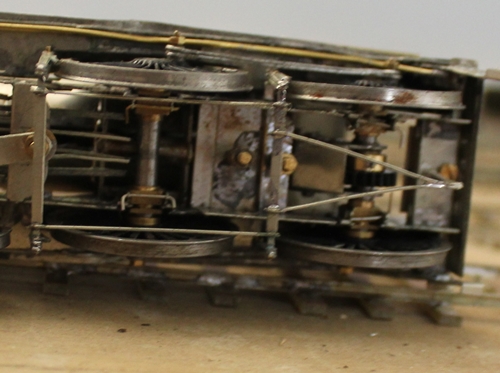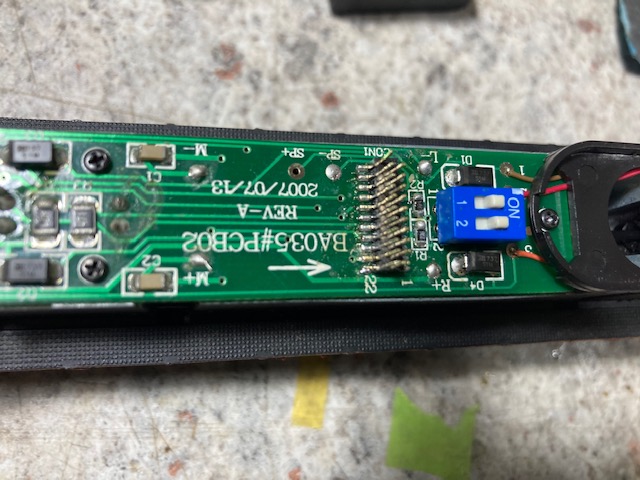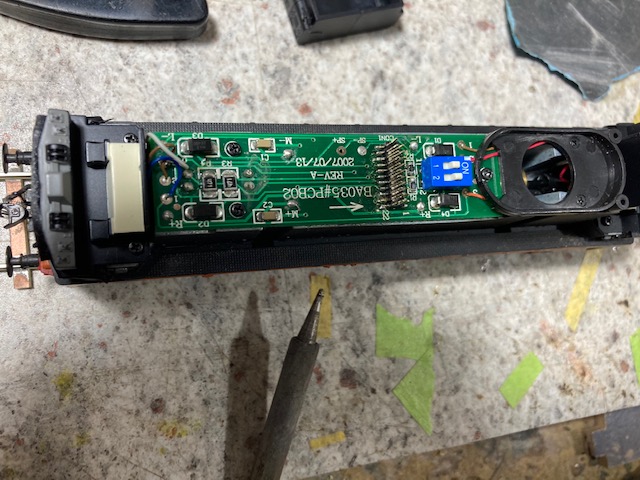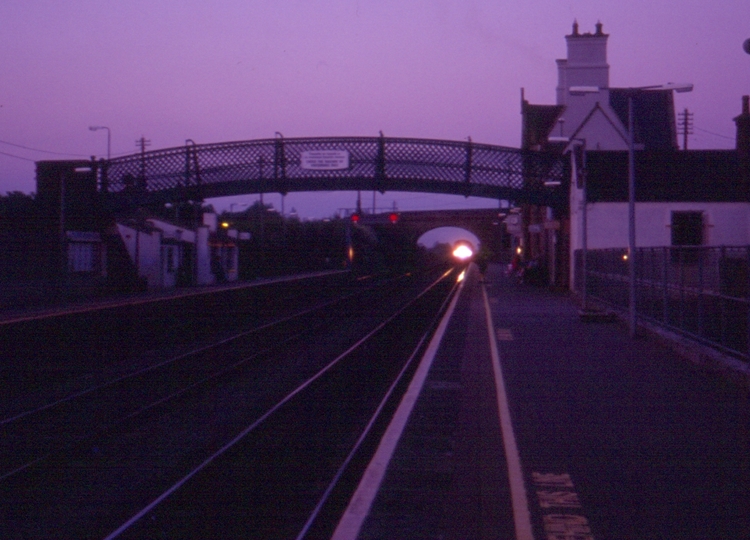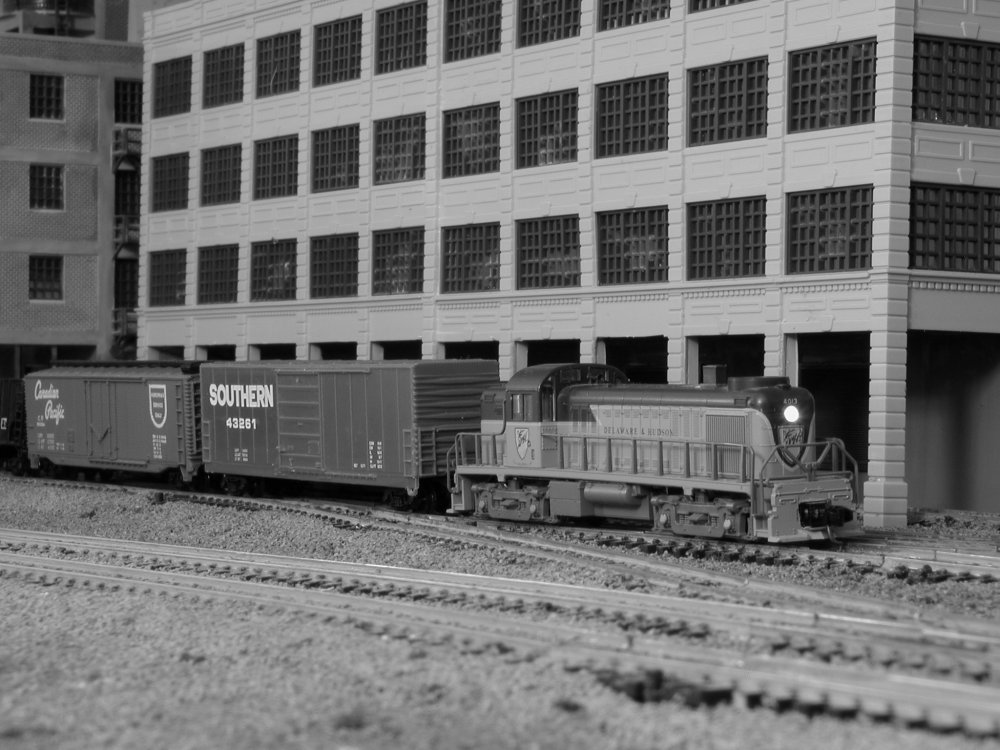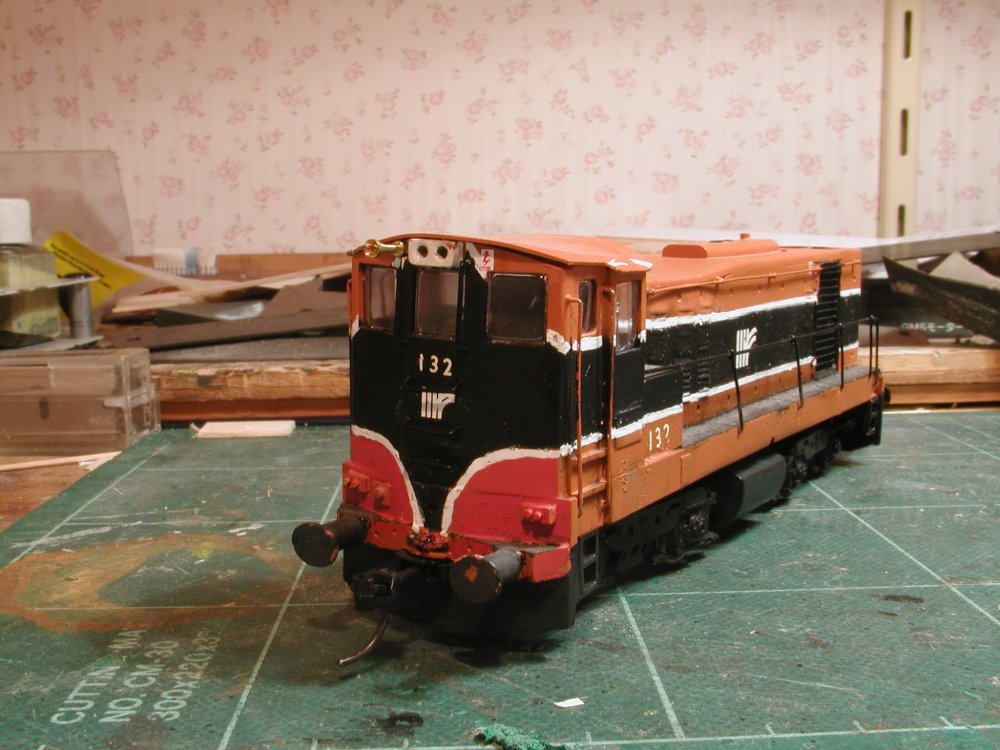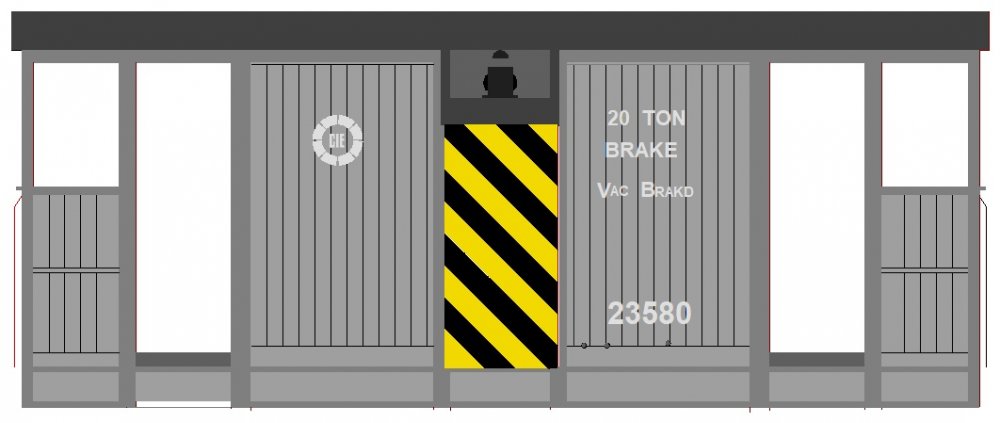-
Posts
4,887 -
Joined
-
Last visited
-
Days Won
119
Content Type
Profiles
Forums
Events
Gallery
Blogs
Community Map
Everything posted by Mayner
-
The cable plough was mounted on an ex MGWR War Surplus 40T-60' bogie well wagon 3409m not unlike the Triang R118 bogie wagons https://www.ebay.com/itm/HORNBY-TRIANG-R118-BOGIE-WELL-WAGON-OO-GAUGE-green-boxed-excellent-/164163017816. The original bogies appear to have been replaced with BR Ridemaster style bogies during the conversion to a cable plough. The MGWR bought two batches of Leeds Forge bogie rail wagons 1106-9 in 1921 & 3401-7 for use with the Bretland train in 1924 There is a John Langford photo of GSWR 0-6-0T 201 hauling at least two bogie bolster wagons on a West Cork p.w. train in Ernie Shepherd's Cork Bandon & South Coast Railway book. The wagons have wooden floors with 4 bolsters with short stakes probably intended for carrying 2-3 tiers of rails. Both the MGWR & GSWR? rail wagons are quite different in appearance to the Bachmann & Hornby bogie bolster wagons.
-
Beginning to draw the saga to a conclusion with assembling the tender brake gear, assembling the mechanism and final detailing before hooking the engine up to the tender. The tender brake gear was assembled as a removable sub-assembly, similar to the loco but a lot more fiddly. First step was to drilled out the pin holes using 0.5mm and 0.8mm drills in a pin chuck. The 0.8 holes are for attaching the hangers to the pivot points on the chassis. Brake shoes soldered to the hangers. First stage in assembling the brake gear solder one pull rod to an 0.45mm brass stretcher bar. The idea was to thread the four of the brake shoes and the remaining pull rods onto the stretcher bars before fixing in place on the chassis in a similar manner to the loco. The original idea was to solder the outer pullrods in place before soldering the inner pullrods and brake hangers in place, with card spacers to keep the outer rods clear of the wheels. In practice it would have been simpler to solder the pullrods to the stretcher bars on a jig on the bench then solder the hangers in place once fitted to the chassis, the center pullrod and hangers were threaded in place once the assembly was fitted to the chassis. GSWR 1864 gal tender chassis with distinctive double brake pull-rod arrangement. The wheels are temporary Hornby coach wheels as I am out of stock of Markits tender wheels. The outer pull rods need to be realigned so that they are parallel to the inner pair before the chassis is painted. Final? stage of tender detailing brake shaft and linkage. I still need to manufacture a pattern for the tank filler and cap. Motor is a 10X20 coreless type supplied by High Level Kits, gearbox is a High Level Road Runner + set up in an L configuration. This arrangement keeps the motor and drive largely clear of the cab with the motor set low in the boiler/firebox. Loco is wired for DC with the "American" pick up system with the motor bonded to the loco frames and a flexible connecting to the tender. Final loco and tender components. Drawbar formed from a piece of copper clad sleepering. Brake shaft and pipework. Nearly complete and test run drivers side No98, toolboxes, vacuum pipes and couplings to be fitted cab interior, tender tank filler and ballasting/balancing to be finalised. Running is quite smooth and fast!, but I have to trace and sort out some intermittent shorts between wheels brake riggings and bogie frames. Firemans side.
-

Would you model in 21mm if RTR track and models were readily available?
Mayner replied to BosKonay's topic in Irish Models
IRM and to a lesser degree Murphy Models have already main streamed the possibility of modelling the Irish Broad Gauge using rtr locos and stock with IRMs range of bogie wagons and Murphy Models diesel locos all of which are simple to re-gauge. The IRM bogie wagons are convertible to Broad Gauge by simply moving out the existing NMRA 110 wheels on the axle or replacing with EM or S4 profile wheels. Conversion of the MM B141 and 071 to broad gauge involves removing the existing wheels and drive gear from the axle and fitting to a 26mm plain axle which can be cut from a piece of 2mm silver steel rod or replacing the MM wheelsets if you work to EM or S4 standards. I re-wheeled two of my 141s with EM profile wheels as the wider stock MM wheels rubbed on the inside of the bogie frames when pushed out to 21mm gauge with a back to back of 19.3mm. The question of whether there is enough demand for a rtr "21mm gauge" track system and rolling stock is an interesting one. Peco developed a rtr EM gauge track system in conjunction with or for the EM Gauge Society and Sutton Locomotive Works produce a rtr Class 24 diesel that is available in OO, EM and P4 which indicates a possible "mainstreaming" of the 'finer scales". The EM and S4 Societies are both long established organisations with established standards and a considerable level of trade support including rtr flexible track systems, point kits and wheel & wheelset manufacturers. 21mm gauge is pretty much a minority interest within the Irish modelling community with possibly less than 20 people actively modelling in the gauge. The majority of people who work in 21mm gauge tend to be modellers who enjoy the technical challenges of building (possibly offbeat)models as opposed to running trains (operating) or collecting models. 21mm gauge layout is likely to occupy a larger space than an equivalent OO gauge layout because of the requirement for larger minimum radius curves than in OO, it would be difficult to build a large complex layout in a typical spare bedroom, single garage or attic found in the typical Irish or UK semi-detached house let alone a modern apartment or older terrace house. Similar minimum radiuses to OO may be achievable by adapting similar track & wheel standards to OO, but would involve the compromise of reducing the gauge or increasing the width of some models to provide sufficient sideplay to run round curves. A 21mm gauge model of a WT 2-6-4 or a D17 4-4-0 may be achievable if designed and built to S4 or EM standards but the gauge would have to be narrowed or the width increased in a model fitted with the wider NMRA 110 wheels. Approx 0.5 mm clearance between driving wheel and inside face of splashers on 21mm gauge D17 built using EM profile wheels (2.4mm width) and 19.3mm back to back gauge. The splashers on this model were moved out to achieve sufficient running clearance, the gauge would have to be decreased or the width of the model considerably increased to compensate for increased wheel tyre width and increased component thickness in a plastic injection molded model. -
First day of 2021 a good opportunity to crack on with the assembly and fitting of the brake gear and coupling rods. I usually design and assemble the brake gear as a separate sub-assembly that can be removed from the chassis for painting and maintenance, the 52 Class added a few additional challenges due to the brake hanger design which is similar to other late 19th GSWR passenger tender and tank locomotives. Each brake hanger and shoe assembly is made up from 3 separate pieces. First step is to drill out the pivot holes 0.8mm and the holes for the brake shoes 0.5mm before removing from the fret using my trusty pin chuck I haven't been able to achieve a clear close up photo of the drilling operation. I made up a simple assembly jig for the brake hangers using a piece of hardwood and short pieces of 0.7 & 0.45 mm brass wire. The first stage of the assembly is to fold over at 180° the "washers" at the top and bottom of the hanger with the half etched brake shoe. The holes in the top of the hanger are circular and intended to be a push fit onto the 0.7mm pivot pins on the chassis, the holes on the bottom of the hanger are square and are designed to fit onto the shouldered ends of the brake stretcher bars. The 0.7mm pin on the left is used to locate and align the pivot point of the hanger, the other pins serve to locate the brake shoe and bottom of the hanger. Stage 2 brake shoe separated from the hanger. Stage 3 the shoe is soldered to both parts of the hanger and the 0.45mm pin. I then removed the pin from the bottom of the hanger before soldering the two sections of the hanger together and then repeating the process for the top pivot point. Brake hanger assemblies awaiting cleaning up. I cleared the top pivot point with an a small tapered broach and an 0.7mm drill and trimmed the pin flush with the sides of the brake hanger. Brake hangers fitted to the loco stretcher-bars and pullrods awaiting assembly. The stretcher bars are shouldered to align the pullrods and brake hangers in the correct position for in this case OO gauge. I first soldered on end of a pull-rod to a stretcher bar making sure that they were at right angles before soldering the other three joints. The rearmost section of the pull rods are formed to shape once the stretcher bars are soldered to the hangers. The photo is of a 21mm chassis but the same principal applies in OO OO Chassis with brake gear and coupling rods fitted! Coupling rods are laminated in two layers from nickel silver . I clamp the rods in a pin vice while soldering the two sections together working along the edge with a soldering iron with a fine tip. Most critical stage of the assembly gradually increasing the size of the holes with a combination of drills and tapered broaches to achieve a clearance fit on the crank pin bushes. This loco is fitted with Markits wheels with their slotted crankpin system which incorporates a slotted securing bush. Almost finished job, tender brake gear and filler cap to be fitted, motor gearbox and power pick ups and couplings before testing and painting. One of the surprising things about designing the model was the small size of the 52 Class for an express passenger loco even compared to the Midland Ks/GSR 650 class not exactly a large loco. Introduced in 1883 the 52 Class were displaced from the Cork expresses by the slightly larger 60 Class during the mid 1880s, curiously Inchacore continued to build both Classes up to 1890. No 1 & No 59
-

Would you model in 21mm if RTR track and models were readily available?
Mayner replied to BosKonay's topic in Irish Models
I think it would be challenging enough developing a 4mm Irish rtr broad gauge track system without going down the rabbit hole of Australian, South American, Indian, Iberian broad gauge. The biggest challenge would be in developing a 'Universal" broad gauge track system that would allow a continuous run layout to be built in a similar space to the same layout in OO, without having to significantly distort the scale of the model. The track and wheel standards cannot be considered in isolation otherwise a manufacturer cannot achieve reliable running. It may be necessary to reduce the track gauge below 21mm to achieve sufficient running clearance on curved track when using NMRA 110 wheels to avoid having to increase the width of locos and stock. From experience 30" radius was the practical limit for 21mm main line diesels and bogie stock using EM profile wheels which have a narrower tyre width than the NMRA110 wheels used as standard with modern rtr rolling stock. In practice it was sometimes challenging fitting EM profile wheels to locos and stock that were designed and built for use on 21mm gauge track, it would be extremely difficult to design or manufacture a 21mm gauge steam outline loco with NMRA 110 wheels capable of running around a curve without having to increase the width of the body, and or move out splashers or outside cylinders if fitted. -
I cheated a bit and fitted handrails and ejector pipework since the last installment. Handrails and pipework are a mixture of 0.45 & 0.9mm straight brass wire from Alan Gibson and short and medium handrail knobs & fine copper wire from the same manufacturer. I drilled out the holes for the cab handrails using an 0.5mm drill and a pin chuck and opened up the holes for the handrail knobs using a taper broach, checking for size with a handrail knob held in a pin vice/chuck, the ejector pipe is held in place with split pins formed from soft copper wire, threaded through the holes in the boiler wrapper and ten soldered in place. I used a piece of thick card as a spacer between the handrails and cab side securing in place with a small stainless steel clamp while soldering the handrail in place form inside the cab. Allowing for OO and 21mm gauge is the biggest challenge in designing the cab interior for an Irish loco. I decided to design a single cab interior that could be assembled in either gauge rather than the two separate fold up interiors incorporated in the design of the MGWR 2-4-0. Splasher/seat assembly, the half etched line in the splasher top/end is for the 21mm version. OO splashers sub-assemblies I am not happy with the excessive width of the OO splashers and will revise this aspect of the design in the production version. Splashers reduced in thickness, with cab floor slotted to fit between loco main frames still not 100% With the loco detailing substantially complete its time to detail the SSM tender. 98s tender is "borrowed" from an SSM J15 kit detailed with a combination of SSM and my own detail castings I decided to mount the springs on 0.45mm brass wire so that the springs can be fitted in place after painting the tender. I drilled the backs of the springs 0.5mm before soldering the pins in place with 100° solder.
-
OO finescale/EM & S4 profile wheels are manufactured by Alan Gibson WorkShops (AGW) http://www.alangibsonworkshop.com/ and Ultrascale Products https://www.ultrascale.uk/. Ultrascale is basically a bespoke manufacturer and will supply 21mm gauge wheels to order difficult to predict lead time in the current circumstances. My preference is for Ultrascale wheels as they are to a higher spec. but also use AGW wheels particularly for steam loco driving wheels a AGW produce a wider range of suitable wheels. I published a tread on the pros & cons of applying EM/OO fine standards to Irish Broad Gauge in 2018. Templot "Irish EM' appears to have been developed by Martin Wynne as EM+2mm similar to his advocacy of EM-2mm to achieve improved running with current OO gauge rtr rolling stock. There may be some advantage in using the Templot standard for re-gauging Murphy Models diesels & IRM bogie wagons while retaining the original NMRA110 wheelsets, but rtr coaches and 4 w freight stock would require modifications/replacement of bogies and running gear for a wider gauge.
-
The smokebox design is fairly typical of etched kits with a half etched wrapper with rivet detail that fits around a fold up former. The former is designed to fold up from a single piece of nickel silver with a spacer to keep everything square, in this case I managed to solder the spacer at an angle, but the overall assembly is square and vertical. Test fit of smokebox former to check that boiler is sitting level before fitting the wrapper. Paper to protect the wrapper in the rolls. Soldering the wrapper in place, the GSWR waisted smokebox wrappers are challenging to form, I checked that the bottom edges of the wrapper were even the same distance from the bottom of the wrapper, before tack soldering the wrapper to the former at the top of the smokebox the re-checking before soldering the wrapper to the top half of the former, then repeating on the other side. I then dressed the skirted section of the wrapper to the former, using suitably sized dowel/aluminium rod as a former then soldering in place. Smokebox front waiting to be soldered in place. I thinned the front of the smokebox former then sweated the front of the wrapper in place, working along the bottom edge of the overlay and the rebate for the smokebox door, this reduces the risk of getting solder on the riveted detail. I use a similar approach soldering the wrapper to the former. Completed smokebox assembly bolted to the boiler, everything sitting level. Starting to look like a loco? Major assembly complete interior and backhead to be fitted
-
There was a thread on this forum on converting IRM wagons to 21mm gauge during 2018 including the ballast wagons. The modifications in the new Irish Lines article appear to be similar to those in the IRM thread. The Bubble Cement may be a more straight forward conversion as there is sufficient width between the axleguards to fit 21mm gauge EM or S4 profile wheelsets but not the wider NMRA110 profile wheelsets used in the majority of rtr rolling stock.
-
One of my Murphy Models 141s developed a mysterious fault which I tracked down to a dry joint between the Bachmann Circuit Board and 21 Pin Decoder interface. The locos is pretty much a 'shelf queen' in a display case and has seldom run since purchased when the locos were originally released. The loco failed to respond to the controller in any way shape or form which pretty much isolated the fault to the circuit between the wheel pick ups and relevant pins on the 21 pin plug. The biggest challenge was finding a reference to the decoder interface that provided a clear illustration of the pin out layout 21 & 22 in the case of track power. It was a simple exercise with a continuity tester to detect the fault which turned out to be a dry soldered joint between the board and in this case pin 22 On inspection it looked like the solder had not penetrated fully around Pins 21 & 22 during the surface mounting process. I re-soldered Pin 22 with a fine tipped soldering iron and a dot of multi-core solder The repair seems to have done the job, it will be interesting to see if a similar problem develops with pin 21.
-
The Grinch (NZ Customs) intercepted my haul of Gypsum wagons on Christmas Eve, on the plus side shipments of 121 locos slopped through under the radar.
-
-
I have been scanning my collection of slides and photos from the late 70s to early 2000s and concur with JHBs observations with very few photos of dirty or run-down locos or stock before 2000. Although both classes of Metrovicks tended to get dirtier quicker than the pure bred GM Classes, I struggle to find a photo of a dirty 001 in my collection. The effect of weathering is tied up with viewing distance a loco or train may look quite clean from a distance and quite dirty close up.
-
I didn't get far with the new layout apart from replacing the stationary decoders on the staging/branch line baseboard with a Triang lever frame which I last used about 14 years ago! I had successfully used the Lenz Decoders to operate Peco point motors, but the Seep motors have a heavier current draw and could potentially exceed the current rating on the Lenz Decoders. The baseboards were successfully re-located to the house on the weekend to free up space in the workshop to start work on a 4mm 21mm gauge layout, which is a good incentive to get the N gauge working and complete some basic scenic work. The big decision at this stage is whether to model the background in the down town area as a typical Appalachian steeply wooded hillside or as a more industrialized area with more large structures and buildings. Unbalanced. Balanced Digital vs 60s technology. Digitrax "Duplex" walk around radio control for running trains and Triang level frame for controlling switches (points) The Mission Control Office, Workbench, Keadue and archive. Keadue is firmly in the Analogue age, points are operated by "Blue Point Motors" (push-pul rod with built in auxilary switches). Trains are controlled by simple hand held Gaugemaster & hand built controllers that plug into DIN sockets mounted on the fascia, one for the main line one for the yard. Section switching is through the 'Blue Point" auxilary switch using Stewart Hine's "linked section control" concept which basically eliminates the requirement for a control panel or separate section switches, a couple of section switches are used for isolating locos in the loco shed coal stage area. Back to where it all started Dublin c2001 Kato D&H RS2 switches the warehouse complex on the old Binghampton layout.
-
I built a whitemetal MIR 141 in Supertrain livery in the mid 90s. Solder assembly with added detail on a simple brass chassis with shortened Athearn GP35 drive, would pull any train with the combination of all metal body and all wheel drive. I also built a pair of 121s in IE livery but whimped out and used Athearn SW1500 Chassis, the 121s were let down by my crude attempt at the IE Tippex stripes. I sold them before heading South, would make an interesting time capsule I wonder are they still about? Before the days of DCC or sound! my attempt at 132 assembled from a whitemetal MIR kit a little worse for wear and crude Tippex stripes.
-
The 23 & 72 goodness gracious David! As a kid in the 1960s my mother used to take the 23 to visit her elderly aunts in North Richmond Street and the 72 to visit her sister off the Oxmontown Road usually R or RA busses, for me the highlight of the 23 was a brief glimpse of the railway at Island Bridge Junction though I didn't get to travel upstairs unless my father came along.
-
The Christmas bottle of whiskey or brandy to important clients and customers was pretty much an expectation in the construction industry in Ireland and to a lesser degree the UK. Quite a different culture in New Zealand where there is no similar expectation and clients appeared genuinely surprised to receive a Christmas present.
-
A classical historical/heritage building dilemma, no income stream to offset the cost of owning/maintaining the building. A Civil Damages claim would probably cost a lot less than restoring/renovating the old station. Perhaps Kilkenny City Council or a local historical group could take over responsibility for maintaining the old station if CIE are unable to find a tenant.
-
1100 & 1101 later B113 & 114 were built with oil fired steam heating boilers similar to British Railways diesels. The boilers were removed at some stage after the "Tin Vans" were introduced in the mid 1950s. The UTA heating van looks like a shortened version of the self-propelled armored trollies built by the NCC during WWII. The trollies were disguised as bulk cement wagons and fitted with a Leyland engine, gearbox and transmission and were intended to patrol the NCC lines to detect sabotage.
- 35 replies
-
- 2
-

-

-
The brake van roofs are slightly lower than the H Vans a distinctive feature of the prototype. The decorated sample was to test whether the printers could achieve the required standard before producing the more complex post 1963 scheme with CIE roundels and ducket wasp stripes. 23580 Grey Post 1963 B23586 Red Oxide late 1960s Unfortunately the project experienced a set back this week, our printer received notice to vacate their premises in February which is likely to have a knock on effect on production. I hope to make an announcement once I have clarity on the printing situation.
-

Ernies Massive Irish 1930's to 2005 Photo Archive
Mayner replied to Glenderg's topic in Photos & Videos of the Prototype
P J Flannigan's theory for "The King" retaining its nameplate was that the loco seldom left Ballinamore Works yard as the loco tended to spread the track on the curves. No 8 is supposed to have 'lost' her nameplates at some remote spot on the Arigna Tramway. I wonder did the GSR melt down or sell the plates. -
The Heritage Officers main role appears to have been protecting IEs interests in connection with maintenance, alterations to or demolition of Protected or Listed buildings and structures. A lot of his work was tied up covering off the "Heritage" aspects of major rail projects during the late 90s early 20s. Such as the Kildare Route Project, Heuston Station re-modelling and improvements to stations like Kilkenny, Mullingar and Dromod where existing heritage buildings were retained in the new station design rather than being demolished and replaced with more utilitarian buildings.
-
We received the decorated sample of the van in the CIE Flying Snail scheme today, so could not resist doing an update this evening! Working with an Auckland based pad printing business & SSM to produce the graphic design was the final piece in the jigsaw to produce the Brake Van as a rtr model as opposed to a kit. We have finalised the 3D CAD work for the model including a re-designed roof and removable NEM coupler pockets to allow modellers to fit their personal choice of couplers. The van will be supplied in OO with either Markits or NorthYard NMRA 110 profile wheels and tension lock couplers, the van is designed to be re-gauged to 21mm either by pushing out the stock wheels on their axles or replacing with EM or P4 wheelsets. The brake shoes are a push fit into rebates in the chassis. The production version will be 3D printed in resin using SLA technology as the numbers did not stack up for a plastic injection moulded model and resin casting was not an available option. There are a few issues related to the limitations of the 3D printing process which we hope to resolve including those little dimples visible in one balcony end. We expect to start marketing the model through on-line media and the Model Press during the first quarter of 2021 for potential release in Mid-Late 2021
- 10 replies
-
- 17
-

-

-

-
B125 & 126s arrived this afternoon 7 days after shipment from IRM in Dublin & just a day late for my birthday.! Meanwhile B131 is on its way from Rails wonder when it will turn up? B121 was fine after its journey 126s with a broken leading vacuum pipe and damaged snatcher on the 2nd mans side. The big question is whether they are re-gaugable to 21mm and to find a space in the display case for them along with my other Murphy Models diesels
-
There are several photos of B121 Class in as delivered condition in the IRRS flickr album The B121 appear to have been delivered with twin marker lights on both sides same as the Metrovicks and B101 Class Sulzers. The G611 & B141 Classes appear to have been delivered with the 2+1 arrangement. In practice locos seldom ran with the marker lights illuminated (in day light hours anyway). On CIE/IE loco head lights were not used in daylight hours until an instruction went out in the 1990s to run with headlights illuminated in daylight hours. Light locos would have carried a separate tail lamp to indicate the train is complete rather than depend on a single red marker lamp.
.png.c363cdf5c3fb7955cd92a55eb6dbbae0.png)


